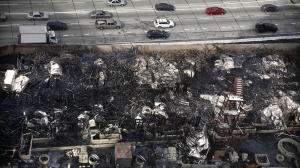Los Angeles Blaze Calls Building Codes into Question
Concrete Industry Opposes Further Relaxing of Codes
SKOKIE, Ill.— The fire that ruined buildings and snarled traffic in downtown Los Angeles this week may not have happened ten years ago. However, loosening of the building codes and the increasing importance on low-cost construction is putting Los Angeles and other areas at risk.
“Taller and larger wood buildings are part of trend to relax fire protection provisions in building design and construction to reduce costs,” says Stephen S. Szoke, PCA senior director of codes and standards. “It saves on initial costs by using cheaper building construction than traditional non-combustible materials such as concrete, masonry or steel and puts buildings under construction at a greater risk of fire.”
Taller and larger wood buildings are part of trend to relax fire protection provisions in building design and construction to reduce costs.
The model building code used as the basis for most city and state building codes is the International Code Council International Building Code. The 2012 edition of the IBC, limits the height of load-bearing combustible construction to four stories for residential construction. A building using load-bearing walls of combustible wood construction can have a total height of five stories if the building is sprinklered and at least the first floor is constructed of fire resistance rated noncombustible construction, such as concrete or masonry. But, a sprinkler requirement cannot protect the building and structures around if a fire breaks out during construction.
Structures built with non-combustible materials prevent the spread of fire, even when a sprinkler system fails – as can happen in an earthquake or when a building is still under construction and the sprinkler system has not yet been installed. In 2007 when construction was at an all-time high, the most common form of five- and six-story residential construction used load-bearing concrete masonry walls with precast concrete floors.
“Common sense shows that buildings build of non-combustible materials are not the same risk of fire damage,” says Szoke. “According to a recent National Fire Protection Association report during a five-year span, departments responded to nearly 830 construction fires. Aftermath pictures routinely show that it is only the wood portion that burned away. Concrete staircases and elevator shafts are still intact. The Los Angeles fire only caused structural damage. If codes are not changed, the next one could cause loss of life.”
About PCA
Based in Washington, D.C., with offices in Skokie, Illinois, the Portland Cement Association represents cement companies in the United States. It conducts market development, engineering, research, education, and public affairs programs. More information on PCA programs is available at www.cement.org.











I wonder what they California government is going to do for the fire suppression systems now that they are in this drought. In the case of this building it was because the sprinkler system was never installed but do they still install sprinkler systems even though they are in a drought? I wonder if they have some sort of different system so they don’t use too much water.